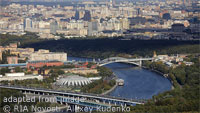Moscow’s Facelift as Modernization

(Kennan Institute – wilsoncenter.org/program/kennan-institute – MAXIM TRUDOLYUBOV – July 27, 2017)
Maxim Trudolyubov, Senior Fellow with the Kennan Institute and editor-at-large with Vedomosti, has been following Russian economy and politics since the late 1990s. He has served as an opinion page editor for Vedomosti and editor and correspondent for the newspaper Kapital
Central Moscow has been a scene of digging and dredging for about three years now. Muscovites have gone from denial, anger, bargaining, all the way to acceptance. The current mood in Moscow: “We are in this forever.”
“People often ask me when our works will end. Here is my response: they will never end,” Moscow’s Deputy Mayor Petr Biryukov said recently. “A good housekeeper is always at work, he is doing this together with his children, younger ones, older ones. We are the owners of our city. Our work for Moscow’s benefit will last indefinitely.”
About 130 billion rubles (over $2 billion) is budgeted over three years for a program called “My Street” that has been underway since 2015. In reality, the program costs more than that. Moscow spent three times the amount specifically allocated to “My street” on urban improvements in 2016 alone, Vedomosti reported.
One has to give the Moscow municipal government its due. The quality of the works has been steadily improving. As opposed to some sorry 2015 examples, the bits and pieces that have been finished recently (this or this) look top class and would stand up against the best examples of urban renewal projects worldwide (think New York’s High Line or Berlin’s Park Am Gleisdreieck).
Moscow’s trendy cafes are bursting with patrons. Barber shops, a relatively recent fad, are staffed with hairstylists so hip, I cannot remember such a concentration of fashionable young men with beards and tattoos anywhere in major world capitals.
Of course, urban projects are expensive and there is a controversy over some of the lucky contractors. Many of the streets have been made and remade more than twice. But Russia is hardly a world champion in efficient spending and Moscow’s current work is not the worst case.
Even the damning revelation of a major corruption scandal underlying the entire project-if it ever transpires-will not overturn the benefits that the residents of central Moscow are getting. The tourists who will visit Russia next year for the FIFA World Cup will like what they see. I can remember the comparable facelift that took place in time for the 1980 Olympics. Young as I was at the time, I can remember the building frenzy and the tidying up of the city for international guests to enjoy. The 1980 Summer Games were a major showcase event for the Soviet Union, which had just started a war in Afghanistan and suffered bad press not unlike that which Russia faces now.
Both the 2014 Sochi Winter Games and the 2018 World Cup could be viewed as showcase events of our time, but historical parallels are only so good. Today’s Russia is no Soviet Union; its economy is smaller, but more dynamic and the borders are a lot more open. The information bubble that has been hovering over Russia’s public sphere is porous enough for alternative viewpoints to circulate widely in our country.
Moscow’s truly impressive effort is its major modernizing drive. The problem with this is that the modernization in question is skin-deep. And it is the only kind of modernization the country gets. A lot of it is indeed about creating attractive scenery, rather than reforming the city that chokes on traffic fumes and imposes crazy commuting times on anyone who cannot afford to reside in the center (the majority of the city’s working population).
It is not just Moscow. Many Russian cities, from Kaliningrad to Vladivostok, are starting urban improvements along the same lines. All in all, 210 public spaces will be renovated in 40 regional centers this year, officials say. This is a welcome development as there are cities in Russia that desperately need attention. But the budget for the entire enterprise is telling: it is 42 billion rubles (about $700 million), a third of the funds allocated in Moscow alone. Let this sink in: $2 billion for Moscow and $700 million for the country’s 40 major cities (the list excludes Kazan, St. Petersburg, and Sochi as they have renovation programs of their own).
The designs that Russia’s regional capitals will be using are even more superficial than the one that Moscow is implementing now, experts say. “So far, it resembles a new décor rather than a new design,” Irina Irbitskaya, director of the Center for Urban Planning Competence, says in an interview with Vedomosti.
On a more fundamental note, the kind of renovation Moscow is pursuing is both welcome and troubling. It is creating a friendly and modern environment in the urban center, because it can afford to. Moscow’s glamor is a reflection of the emptiness and backwardness of the rest of the country. Three quarters of the country’s regions are losing population. Only ten of Russia’s regions attract people who are looking for jobs, and Moscow alone pulls in 51 percent of all domestic labor migrants, according to an interesting recent report on labor mobility in Russia.
Russia needs to empower people all over the vast country, not just create showcase environments in urban centers. By organizing international sporting events and improvement works, the Kremlin is cementing its grip on the centralized resource distribution that is its main domestic political tool. Russia’s incredibly contorted population scheme is getting cemented as well. Moscow renewal is paving the way for the next major initiative of the central authorities: a demolition and construction program that would see the five-story housing blocks built in the 1960s and 1970s razed and larger and trendier structures built in their stead. This will further concentrate the population and power in Moscow. We will take a look at this story in my next piece.
